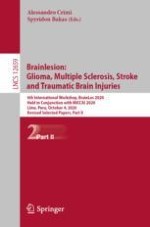This two-volume set LNCS 12658 and 12659 constitutes the thoroughly refereed proceedings of the 6th International MICCAI Brainlesion Workshop, BrainLes 2020, the International Multimodal Brain Tumor Segmentation (BraTS) challenge, and the Computational Precision Medicine: Radiology-Pathology Challenge on Brain Tumor Classification (CPM-RadPath) challenge. These were held jointly at the 23rd Medical Image Computing for Computer Assisted Intervention Conference, MICCAI 2020, in Lima, Peru, in October 2020.*
The revised selected papers presented in these volumes were organized in the following topical sections: brain lesion image analysis (16 selected papers from 21 submissions); brain tumor image segmentation (69 selected papers from 75 submissions); and computational precision medicine: radiology-pathology challenge on brain tumor classification (6 selected papers from 6 submissions).
*The workshop and challenges were held virtually.
